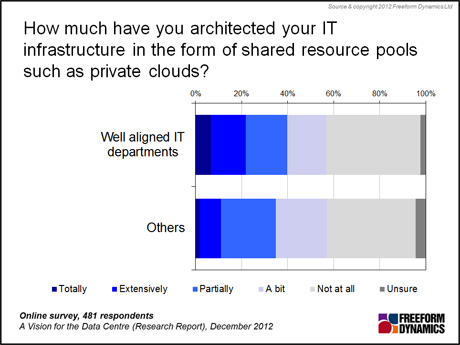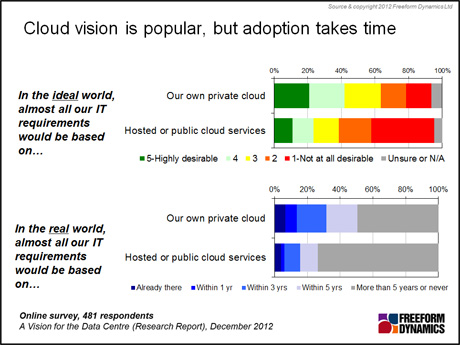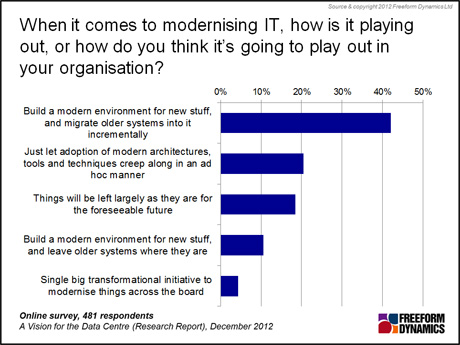By Andrew Buss
The last decade has seen massive leaps in performance and capability across all areas of IT. This has enabled organisations of all sizes and types to approach doing business in new ways, or to do things better and more effectively. Despite this, many companies feel that the actual service delivered by IT often falls short of what is needed and expected. The end result is a lack of alignment between the direction and goals of the business and what IT is able to deliver.
Driving better alignment between business and IT is therefore usually at, or at least very near, the top of the list of priorities for CIOs and IT Directors, even if not formally documented as such. When we look at the top requirements that many companies have of their IT departments, it is to be responsive to requests for new or enhanced services, for performance and reliability guarantees to be met, for costs to be contained and more value to be delivered.
While the success of this type of alignment initiative is very dependent on the abilities and drive of people involved, architectural and technology choices and investment in the datacentre can have a real impact on how this goal is realised. In order to meet the requirements of agility, availability and performance, a great deal comes down to effective and automated service provisioning coupled with comprehensive service monitoring and management.
These are principles which underpin the concepts of Private Cloud, so we would expect those IT departments which are better aligned with business objectives to also be leading the way when it comes to the adoption of private cloud and this is indeed the case (Figure 1).

Figure 1
It is not only well aligned IT organisations that grasp the benefits that private cloud can bring. If the constraints of the real world are removed, the concept resonates strongly with many IT managers. However, when it comes to the practicalities of implementing a private cloud many companies are still in the stages of thinking about it rather than moving forward at this point (Figure 2).

Figure 2
A minority may never be convinced of the benefits of a more dynamic approach to IT, but for most this is an appealing vision and one that delivers tangible benefits for those that have already made the move.
The end result is that the datacentre of the future will be built increasingly around the concepts of private cloud, including automation, orchestration, service level agreements, unified infrastructure and proactive monitoring and management. This may seem pretty obvious when sitting back and thinking about it.
But the way that projects and budget focus the attention on the here and now often means that the bigger picture is by necessity put off for another day – usually many times over. Making the case and getting started is often the hardest part, and to do this it can be useful to consider some of the architectural options that can shape your investment towards better alignment and more dynamic IT.
Evolution rather than big bang
While IT vendors may like to imply that the way to solve many of the problems facing the datacentre infrastructure is to sweep out the old and replace it en-masse, the path to private cloud is definitely not about a big transformational change.
For most IT organisations, it is very much about choosing a path that allows incremental improvements that helps make an initially small – but growing – part of the IT infrastructure more dynamic and ‘cloud like’ while preserving and even enhancing what is already in place (Figure 3).

Figure 3
This then raises the question of what to do about existing or legacy workloads and systems. Leaving them where they are can simplify the introduction of modern environments such as private cloud, allowing a focus purely on supporting the new workloads. The end result is typically a smoother introduction with less time, cost and associated risk for the new environment.
Enhance the old, but not at any cost
This however, then leaves the older workloads without the benefits of advances in architecture and management that come with cloud type environments. The result is continuing fragmentation of the IT infrastructure, with workload or service ‘islands’ emerging that may not function very well together. They may also introduce, in areas such as change management or provisioning, potential bottlenecks that impact on how effective the modern environment is able to be.
The other approach is to try to gradually migrate the older services into the new environment. The advantage here is that these systems can start to benefit from much of the investment in shared services that are being integrated into the new infrastructure, with the potential for improved monitoring, management and flexibility. It is no surprise then that this is by far the most popular approach to modernising IT among the respondents.
On the surface, this approach makes a lot of sense. But if taken too far can have unintended or negative consequences. The ultimate aim is to be able to move workloads where it can be done quite easily in terms of compatibility and performance, and where the effort involved does not result in having to compromise the implementation or functionality of the new, modern environment.
The ideal is not to think about forcing older workloads into the new system at any cost. Instead, a pragmatic approach is needed, with an understanding of the end goal of a successful migration. An assessment period would examine the feasibility of migration, and should any issues arise the decision can be made to either invest in migration so long as it does not interfere with the new environment, or to leave the workload as it is.
Content Contributors: Andrew Buss